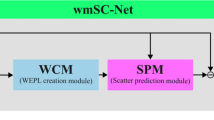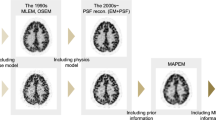Abstract
Micro-computed tomography (micro-CT) enables the non-destructive acquisition of three-dimensional (3D) morphological structures at the micrometer scale. Although it is expected to be used in pathology and histology to analyze the 3D microstructure of tissues, micro-CT imaging of tissue specimens requires a long scan time. A high-speed imaging method, sparse-view CT, can reduce the total scan time and radiation dose; however, it causes severe streak artifacts on tomographic images reconstructed with analytical algorithms due to insufficient sampling. In this paper, we propose an artifact reduction method for 3D volume projection data from sparse-view micro-CT. Specifically, we developed a patch-based lightweight fully convolutional network to estimate full-view 3D volume projection data from sparse-view 3D volume projection data. We evaluated the effectiveness of the proposed method using physically acquired datasets. The qualitative and quantitative results showed that the proposed method achieved high estimation accuracy and suppressed streak artifacts in the reconstructed images. In addition, we confirmed that the proposed method requires both short training and prediction times. Our study demonstrates that the proposed method has great potential for artifact reduction for 3D volume projection data under sparse-view conditions.
















Similar content being viewed by others
References
Du Plessis A, Broeckhoven C, Guelpa A, Le Roux SG. Laboratory x-ray micro-computed tomography: a user guideline for biological samples. Gigascience. 2017;6(6):1–11.
Favata J, Shahbazmohamadi S. Realistic non-destructive testing of integrated circuit bond wiring using 3-D X-ray tomography, reverse engineering, and finite element analysis. Microelectron Reliab. 2018;83:91–100.
Chung SY, Kim JS, Stephan D, Han TS. Overview of the use of micro-computed tomography (micro-CT) to investigate the relation between the material characteristics and properties of cement-based materials. Constr Build Mater. 2019;229: 116843.
Du Plessis A, Le Roux SG, Els J, Booysen G, Blaine DC. Application of microCT to the non-destructive testing of an additive manufactured titanium component. Case Stud Nondestruct Test Eval. 2015;4:1–7.
Hutchinson JC, Shelmerdine SC, Simcock IC, Sebire NJ, Arthurs OJ. Early clinical applications for imaging at microscopic detail: microfocus computed tomography (micro-CT). Br J Radiol. 2017;90:107520170113.
Senter-Zapata M, Patel K, Bautista PA, Griffin M, Michaelson J, Yagi Y. The role of micro-CT in 3D histology imaging. Pathobiology. 2016;83:140–7.
Albers J, Pacilé S, Markus MA, Wiart M, Vande Velde G, Tromba G, Dullin C. X-ray-based 3D virtual histology—adding the next dimension to histological analysis. Mol Imaging Biol. 2018;20(5):732–41.
Katsamenis OL, Olding M, Warner JA, Chatelet DS, Jones MG, Sgalla G, et al. X-ray micro-computed tomography for nondestructive three-dimensional (3D) X-ray histology. Am J Pathol. 2019;189(8):1608–20.
Scott AE, Vasilescu DM, Seal KA, Keyes SD, Mavrogordato MN, Hogg JC, et al. Three dimensional imaging of paraffin embedded human lung tissue samples by micro-computed tomography. PLoS ONE. 2015;10(6): e0126230.
Tang R, Saksena M, Coopey SB, Fernandez L, Buckley JM, Lei L, et al. Intraoperative micro-computed tomography (micro-CT): a novel method for determination of primary tumour dimensions in breast cancer specimens. Br J Radiol. 2016;89:20150581.
Xu B, Teplov A, Ibrahim K, Inoue T, Stueben B, Katabi N, et al. Detection and assessment of capsular invasion, vascular invasion and lymph node metastasis volume in thyroid carcinoma using microCT scanning of paraffin tissue blocks (3D whole block imaging): a proof of concept. Mod Pathol. 2020;33(12):2449–57.
Jones MG, Fabre A, Schneider P, Cinetto F, Sgalla G, Mavrogordato M, et al. Three-dimensional characterization of fibroblast foci in idiopathic pulmonary fibrosis. JCI Insight. 2016;1(5):e86375. https://doi.org/10.1172/jci.insight.86375.
Teplov A, Tabata K, Fu X, Uraoka N, A Roehrl MH, Ntiamoah P, et al. Development of standard operating procedure (SOP) of micro-computed tomography (micro-CT) in pathology. Diagn Pathol. 2019;5(1). https://doi.org/10.17629/www.diagnosticpathology.eu-2019-5:273.
Kudo H, Suzuki T, Rashed EA. Image reconstruction for sparse-view CT and interior CT—introduction to compressed sensing and differentiated backprojection. Quant Imaging Med Surg. 2013;3(3):147–61.
Frikel J. Sparse regularization in limited angle tomography. Appl Comput Harmon Anal. 2013;34(1):117–41.
Feldkamp LA, Davis LC, Kress JW. Practical cone-beam algorithm. J Opt Soc Am A. 1984;1(6):612–9.
Candes EJ, Romberg J, Tao T. Robust uncertainty principles: exact signal reconstruction from highly incomplete frequency information. IEEE Trans Inf Theory. 2006;52(2):489–509.
Donoho DL. Compressed sensing. IEEE Trans Inf Theory. 2006;52(4):1289–306.
Han Y, Ye JC. Framing U-Net via deep convolutional framelets: application to sparse-view CT. IEEE Trans Med Imaging. 2018;37(6):1418–29.
Shan H, Zhang Y, Yang Q, Kruger U, Kalra MK, Sun L, et al. 3-D convolutional encoder-decoder network for low-dose CT via transfer learning from a 2-D trained network. IEEE Trans Med Imaging. 2018;37(6):1522–34.
Xie S, Zheng X, Chen Y, Xie L, Liu J, Zhang Y, et al. Artifact removal using improved GoogLeNet for sparse-view CT reconstruction. Sci Rep. 2018;8:6700.
Zhang Z, Liang X, Dong X, Xie Y, Cao G. A sparse-view CT reconstruction method based on combination of DenseNet and deconvolution. IEEE Trans Med Imaging. 2018;37(6):1407–17.
Chen H, Zhang Y, Kalra MK, Lin F, Chen Y, Liao P, et al. Low-dose CT with a residual encoder-decoder convolutional neural network. IEEE Trans Med Imaging. 2017;36(12):2524–35.
Wolterink JM, Leiner T, Viergever MA, Išgum I. Generative adversarial networks for noise reduction in low-dose CT. IEEE Trans Med Imaging. 2017;36(12):2536–45.
You C, Yang Q, Shan H, Gjesteby L, Li G, Ju S, et al. Structurally-sensitive multi-scale deep neural network for low-dose CT denoising. IEEE Access. 2018;6:41839–55.
You C, Li G, Zhang Y, Zhang X, Shan H, Li M, et al. CT super-resolution GAN constrained by the identical, residual, and cycle learning ensemble (GAN-CIRCLE). IEEE Trans Med Imaging. 2020;39(1):188–203.
Lee H, Lee J, Kim H, Cho B, Cho S. Deep-neural-network-based sinogram synthesis for sparse-view CT image reconstruction. IEEE Trans Radiat Plasma Med Sci. 2019;3(2):109–19.
Dong X, Vekhande S, Cao G. Sinogram interpolation for sparse-view micro-CT with deep learning neural network. Proc SPIE. 2019;10948:109482O.
Lee D, Choi S, Kim HJ. High quality imaging from sparsely sampled computed tomography data with deep learning and wavelet transform in various domains. Med Phys. 2019;46(1):104–15.
Yin X, Zhao Q, Liu J, Yang W, Yang J, Quan G, et al. Domain progressive 3D residual convolution network to improve low-dose CT imaging. IEEE Trans Med Imaging. 2019;38(12):2903–13.
Goodfellow IJ, Pouget-Abadie J, Mirza M, Bing X, Warde-Farley D, Ozair S, et al. Generative Adversarial Nets. In: NIPS. 2014.
Ronneberger O, Fischer P, Brox T. U-Net: Convolutional networks for biomedical image segmentation. In: MICCAI LNCS. 2015; p. 234–41.
Okamoto T, Ohnishi T, Haneishi H. Artifact reduction for sparse-view CT using deep learning with band patch. IEEE Trans Radiat Plasma Med Sci. 2022. https://doi.org/10.1109/TRPMS.2022.3168970.
Yamanaka J, Kuwashima S, Kurita T. Fast and accurate image super resolution by deep CNN with skip connection and network in network. In: ICONIP LNCS. 2017. p. 217–25.
He K, Zhang X, Ren S, Sun J. Deep residual learning for image recognition. In: CVPR. 2016. p. 770–8.
Kim J, Lee JK, Lee KM. Accurate image super-resolution using very deep convolutional networks. In: CVPR. 2016. p.1646–54.
Ledig C, Theis L, Huszar F, Caballero J, Cunningham A, Acosta A et al. Photo-realistic single image super-resolution using a generative adversarial network. In: CVPR. 2017. p.105–14.
Lim B, Son S, Kim H, Nah S, Lee KM. Enhanced deep residual networks for single image super-resolution. In: CVPRW. 2017. p 1132–40.
Tai Y, Yang J, Liu X. Image super-resolution via deep recursive residual network. In: CVPR. 2017. p. 2790–98.
Zhang Y, Tian Y, Kong Y, Zhong B, Fu Y. Residual dense network for image super-resolution. In: CVPR. 2018. p.2472–81.
Maas AL, Hannun AY, Ng AY, Rectifier nonlinearities improve neural network acoustic models. In: ICML. 2013.
Ioffe S, Szegedy C. Batch normalization: accelerating deep network training by reducing internal covariate shift. In: ICML PMLR. 2015. p. 448–56.
Szegedy C, Liu W, Jia Y, Sermanet P, Reed S, Anguelov D et al. Going deeper with convolutions. In: CVPR. 2015. p.1–9.
Szegedy C, Vanhoucke V, Ioffe S, Shlens J, Wojna Z. Rethinking the inception architecture for computer vision. In: CVPR. 2016. p. 2818–26.
Odena A, Dumoulin V, Olah C. Deconvolution and checkerboard artifacts. Distill. 2016. https://doi.org/10.23915/distill.00003.
Der Sarkissian H, Lucka F, van Eijnatten M, Colacicco G, Coban SB, Batenburg KJ. A cone-beam X-ray computed tomography data collection designed for machine learning. Sci Data. 2019;6:215. https://doi.org/10.1038/s41597-019-0235-y.
Der Sarkissian H, Lucka F, van Eijnatten M, Colacicco G, Coban SB, Batenburg KJ. Cone-beam x-ray CT data collection designed for machine learning: samples 1–8. 2021. Zenodo. https://doi.org/10.5281/zenodo.2686726.
Der Sarkissian H, Lucka F, van Eijnatten M, Colacicco G, Coban SB, Batenburg KJ. Cone-beam x-ray CT data collection designed for machine learning: samples 9–16. 2021. Zenodo. https://doi.org/10.5281/zenodo.2686971.
Kingma DP, Ba J. Adam: a method for stochastic optimization. In: ICLR. 2015.
Paszke A, Gross S, Massa F, Lerer A, Bradbury J, Chanan G et al. PyTorch: an imperative style, high-performance deep learning library. In: NeurIPS. 2019. p. 8024–35.
Wang Z, Bovik AC, Sheikh HR, Simoncelli EP. Image quality assessment: from error visibility to structural similarity. IEEE Trans Image Process. 2004;13(4):600–12.
Tanaka E, Kudo H. Optimal relaxation parameters of DRAMA (dynamic RAMLA) aiming at one-pass image reconstruction for 3D-PET. Phys Med Biol. 2010;55(10):2917–39.
Acknowledgements
This research was partly supported by the Japan Society for the Promotion of Science (JSPS), KAKENHI Grant-in-Aid for Scientific Research (A), grant number 19H01172. We wish to thank Machiko Horiuchi from Summit Pharma International Corporation (Tokyo, Japan) for technical assistance with the micro-CT scan experiments.
Author information
Authors and Affiliations
Corresponding author
Ethics declarations
Conflict of interest
Hideaki Haneishi received an unnumbered research grant from Rigaku Corporation (Tokyo, Japan) for research separate from the submitted work.
Ethical approval
This article does not contain any studies with human participants or animals.
Additional information
Publisher's Note
Springer Nature remains neutral with regard to jurisdictional claims in published maps and institutional affiliations.
About this article
Cite this article
Okamoto, T., Kumakiri, T. & Haneishi, H. Patch-based artifact reduction for three-dimensional volume projection data of sparse-view micro-computed tomography. Radiol Phys Technol 15, 206–223 (2022). https://doi.org/10.1007/s12194-022-00661-7
Received:
Revised:
Accepted:
Published:
Issue Date:
DOI: https://doi.org/10.1007/s12194-022-00661-7




